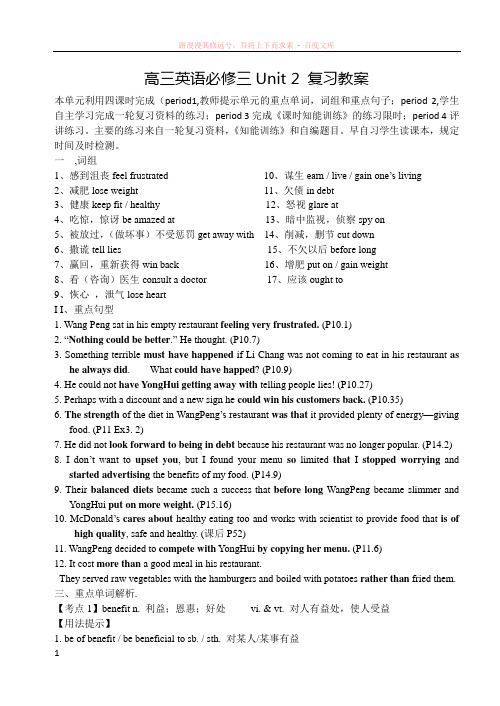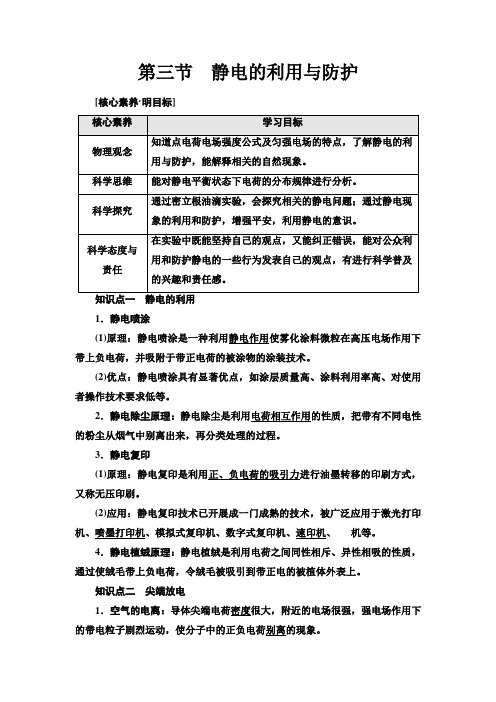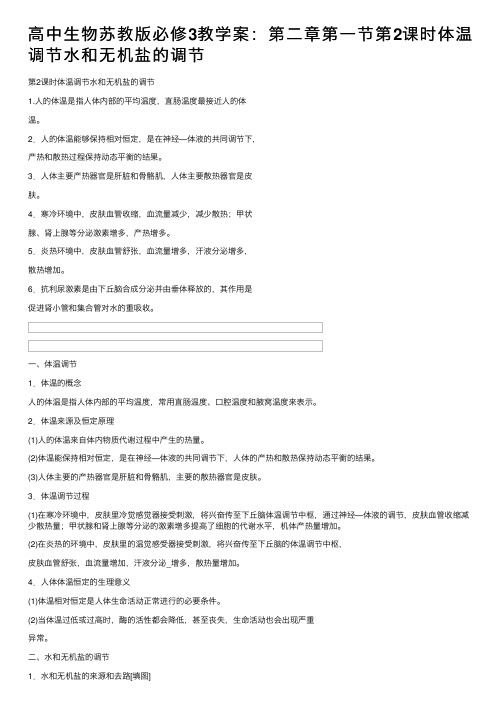学案48必修3第2章学案 教师版
- 格式:doc
- 大小:182.50 KB
- 文档页数:3

英语必修三unit2教案教案标题:Unit 2: Cultural Relics教学目标:1. 了解和掌握与文化遗产相关的词汇和短语。
2. 能够描述和解释文化遗产的重要性和价值。
3. 能够运用所学知识进行相关话题的讨论和写作。
教学重点:1. 文化遗产的定义和种类。
2. 描述和解释文化遗产的重要性和价值。
3. 运用所学知识进行相关话题的讨论和写作。
教学难点:1. 运用适当的词汇和短语描述和解释文化遗产的重要性和价值。
2. 运用所学知识进行相关话题的讨论和写作。
教学准备:1. 多媒体设备和投影仪。
2. 学生用书和教材。
3. 活动和练习的工作表。
教学步骤:Step 1: 导入新课 (5分钟)1. 利用多媒体设备展示一些著名的文化遗产图片,引起学生的兴趣。
2. 引导学生讨论他们对文化遗产的理解和认识。
Step 2: 词汇和短语学习 (15分钟)1. 利用多媒体设备展示文化遗产相关的词汇和短语,如cultural relics, heritage, preservation, etc.2. 进行词汇和短语的发音练习和记忆。
Step 3: 阅读理解 (20分钟)1. 学生阅读教材中关于文化遗产的文章,并回答相关问题。
2. 教师引导学生讨论文章中的重要观点和信息。
Step 4: 语言运用 (15分钟)1. 学生分组进行小组讨论,讨论文化遗产的重要性和价值。
2. 学生使用所学词汇和短语进行表达,并记录下自己的观点。
Step 5: 写作练习 (20分钟)1. 学生根据所给提示写一篇关于自己国家文化遗产的短文。
2. 学生互相交换短文并提供建议和修改意见。
Step 6: 总结和评价 (10分钟)1. 教师总结本节课的重点和要点。
2. 学生进行自我评价并提出问题和困惑。
Step 7: 课堂延伸 (5分钟)1. 学生自主阅读相关的文化遗产文章并写下自己的感想和思考。
2. 学生可以准备一份关于自己最喜欢的文化遗产的简短介绍。

第2节通过激素的调节1.由内分泌器官(或细胞)分泌的化学物质进行的调节,就是激素调节。
2.调节血糖含量的激素主要有胰岛A 细胞分泌的胰高血糖素和胰岛B 细胞分泌的胰岛素。
3.胰岛素能促进组织细胞加速摄取、利用和储存葡萄糖,从而使血糖水平降低。
4.胰高血糖素能促进肝糖原分解和一些非糖物质转化为葡萄糖,从而使血糖水平升高。
5.甲状腺激素分泌的分级调节: 下丘脑――→TRH 垂体――→TSH甲状腺甲状腺激素 6.激素调节的特点:微量和高效,通过体液运输,作用于靶器官、靶细胞。
一、激素调节的发现 1.促胰液素的发现(1)斯他林和贝利斯提出的假设:在盐酸的作用下,小肠黏膜产生了一种化学物质,这种物质进入血液后,随血流到达胰腺,引起胰液的分泌。
(2)实验验证过程:2.激素调节的概念由内分泌器官(或细胞)分泌的化学物质进行的调节,就是激素调节。
3.人体主要内分泌腺及其分泌的激素[连线]二、血糖平衡的调节 1.血糖的来源和去向2.参与血糖调节的主要激素(1)含义:在一个系统中,系统本身工作的效果,反过来又作为信息调节该系统的工作。
(2)意义:是生命系统中非常普遍的调节机制,对于机体维持稳态具有重要意义。
三、甲状腺激素分泌的调节 1.调节过程[据图填空](1)腺体:a.下丘脑,b.垂体,c.甲状腺。
(2)激素:甲:促甲状腺激素释放激素(TRH); 乙:促甲状腺激素(TSH)。
(3)作用:“+”表示促进,“-”表示抑制。
2.调节方式甲状腺激素的分泌既存在分级调节,也存在反馈调节机制。
四、激素调节的特点1.微量和高效。
2.通过体液运输。
3.作用于靶器官、靶细胞,经靶细胞接受并起作用后就被灭活。
4.激素既不组成细胞结构,又不提供能量,也不起催化作用,而是使靶细胞原有的生理活动发生变化。
1.判断下列叙述的正误(1)下丘脑分泌生长激素、促甲状腺激素释放激素等(×)(2)在血糖含量低的情况下,肝糖原和肌糖原都能转化为血糖(×)(3)胰高血糖素主要作用于肝脏,抑制肝糖原的分解(×)(4)胰岛素和胰高血糖素由同一器官分泌且生理效应相反(√)(5)血液中甲状腺激素水平降低会引起促甲状腺激素释放激素分泌减少(×)(6)甲状腺激素的靶器官可以是垂体(√)(7)激素一般对所作用的靶器官或靶细胞具有一定的特异性(√)(8)甲状腺激素可为细胞提供能量从而促进新陈代谢(×)2.下列激素中,由同一种腺体分泌的是( )A.生长激素、促甲状腺激素释放激素、促性腺激素B.促甲状腺激素释放激素、促性腺激素释放激素C.雄性激素、雌性激素、孕激素D.促甲状腺激素、甲状腺激素、促性腺激素解析:选B 生长激素、促甲状腺激素释放激素、促性腺激素分别由垂体、下丘脑和垂体分泌;促甲状腺激素释放激素、促性腺激素释放激素均由下丘脑分泌;雄性激素由睾丸分泌,雌激素、孕激素由卵巢等分泌;促甲状腺激素、甲状腺激素、促性腺激素分别由垂体、甲状腺和垂体分泌。

2019-2020学年高中英语人教版必修三Unit2阅读课导学案2019-2020学年高中英语人教版必修三Unit 2 Healthy eatingPeriod 1: Reading【学习目标】1. 了解饮食及健康的饮食2. 阅读理解王鹏开餐馆的故事3. 认识食物的分类,食物对人体健康的影响,深刻理解均衡饮食的重要性。
4. 训练略读,找读,释义,细读,归纳要点,对比等阅读技巧,把握篇章的中心内容,获取关键信息,并且能复述故事,预测故事的发展和结局。
【重点难点】1. 引导学生认识食物的分类,食物对人体健康的影响,深刻理解均衡饮食的重要性。
2. 掌握略读,找读,释义,细读,归纳要点,对比等阅读技巧,把握篇章的中心内容,获取关键信息,并且能复述故事,预测故事的发展和结局。
【自主预习】预习课本9~11页,大声朗读课文。
【导学流程】一.自主预习检测1. What kinds of nutrients(营养物质) can they provide to human beings?2. What is a balanced diet?If we don’t eat a balanced diet, what may happen?3. How do you think the story will end?二.互动研讨(一)1. Divide the whole passage into three parts, and give the general idea of each part. Para1: Wang Pengwei felt because he found his customers . Para2: Wang Pengwei found the reason .Para3:2. Fast reading: try to get the main ideaWang Pengwei and Yong Hui serve different ______in their restaurant . The foods in Wang Pengwei’s make people _____whil e the foods in Yong Hui’s makepeople________.so his restaurant became .3. Read the passage carefully and judge the sectence and give the reason:1).Usually Wang Pengwei’s restaurant was full of people.( )2).Yong Hui could make people thin in two weeks by giving them a good diet.( )3).Wang Pengwei’s customers often became fat .( )4).Yong Hui’s menu gave them more energy -giving foods.( )5).wang peng’s menu gave customers more protective food.( )6). Wang peng decided to compete with yong hui by copying her menu.( )互动研讨(二)1. In you own words explain the following sentences or parts of sentences taken from the passage.1)Something terrible must hjave happened if li chang was not coming to eat in his restaurant as he always did.Li chang always so if he did not , it meant that somethingserious .2)He could not have yong hui getting away with telling people lies!He did not want yong hui to and people to ,he wouldTell .3)Perhaps with a discount and a new sign he would win his customers back.If he gave his customers and the benefits of his menu, perhaps his customers would2. Read the warming up and the passage again and write out your answers.1)The weakness of the diet in w ang pen’s restaurant was that it did notgive .2)The strength of the diet in wang pen’s restaurant was that it provided. 3)The weaknes of the diet in yong hui’s restaurant was that it did not give4)The strength of the diet in yong hui’s restaurant was that it provided. 三.随堂检测:Wang Pengwei felt ___1____in an empty restaurant because no __2___have come to his restaurant ever since he got up early in the morning. He wanted to find out why. He hurried out and _f__3___ Maochang into a newly-opened restaurant. He found that the owner named Yong Hui was serving _____4___foods to make people thin. Driven byc____5____, Wang Pengwei came f__6___to take a close athe menu. He could not even ___7_ his eyes. He was ____8___ at what he saw. He hurried outside and went to the___9___to do some ___10____. After a lot of reading, he ___11____ that Yong Hui’s food made people become __12___quickly because it was no ____13___food. Arriving home Wang Pengwei rewrote his own sign. The c__14____ between the two restaurants was on!四.课外提升:Sweet potatoes are fat-free, high in fiber and full of the vitamins that research suggests reduce your risk of life-shortening diseases. To stay healthy, we must eat more fruits and vegetables, and sweet potatoes are a great source of beta carotene(胡萝卜素)and other carotenoids(which the body turns into vitamin A). According to a study of the diets of almost 90,000 nurses, eating about one cup a day of fruits and vegetables rich in carotenoids can cut your risk of stroke in half and reduce your risk of heart disease by 22 percent. Other research suggests beta carotene protects against breast, lung and stomach cancers.Beta carotene is the most famous member of the carotenoids family. In face, a medium-sized sweet potato contains nearly 12mg of beta carotene(anti-aging experts usually suggest 6 to 11 mg per day). Sweet potatoes are also a low-fat source of vitaminE. Research has linked high E diets with a lower risk of heart disease. This vitamin pill in an orange jacket also packs a vitamin C punchit which has more C than apricots (a kind of fruit). Research suggests that vitamin C protects against ailments (小疾) ranging from cataracts(an eye disease) to cancer. In addition, a UCLA (University of California Los Angeles) study linked high vitamin C diets with a longer life. Recent studies have showed that antioxidant Vitamins C, E and beta carotene fight a fierce battle against free radicals (自由基),which cause cell (细胞)damage and lead to various illness. Therefore, to keep fit, eat more sweet potatoes.10. According to the text, there exists a lot of ______in sweet potatoes.A. fiber, beta carotene, other carotenoids, Vitamin E and CB. beta carotene, other carotenoids, fiber, Vitamin A and EC. Vitamin A, beta carotene, fiber, Vitamin E and CD. beta carotene, other carotenoids, Vitamin A and E11. This text as a whole suggests that eating sweet potatoes can help______.A. cut your risk of stroke and heart diseaseB. protect against breast, lung and stomach cancersC. protect against ailments ranging from cataracts to cancersD. you stay healthy and reduce your risk of life-shortening diseases12. “ This vitamin pill in an orange jacket”in the passage refers to______.A. sweet potatoB. vitamin C pillC. vitamin E pillD. beta carotene13. The best title of this passage might be______.A. The vitamin superstarB. On sweet potatoesC. Beta carotene and vitaminsD. Diet and disease。

高三英语必修三Unit 2 复习教案本单元利用四课时完成(period1,教师提示单元的重点单词,词组和重点句子;period 2,学生自主学习完成一轮复习资料的练习;period 3完成《课时知能训练》的练习限时;period 4评讲练习。
主要的练习来自一轮复习资料,《知能训练》和自编题目。
早自习学生读课本,规定时间及时检测。
一,词组1、感到沮丧feel frustrated 10、谋生earn / live / gain one’s living2、减肥lose weight 11、欠债in debt3、健康keep fit / healthy 12、怒视glare at4、吃惊,惊讶be amazed at 13、暗中监视,侦察spy on5、被放过,(做坏事)不受惩罚get away with 14、削减,删节cut down6、撒谎tell lies 15、不欠以后before long7、赢回,重新获得win back 16、增肥put on / gain weight8、看(咨询)医生consult a doctor 17、应该ought to9、恢心,泄气lose heartI I、重点句型1. Wang Peng sat in his empty restaurant feeling very frustrated. (P10.1)2. “Nothing could be better.” He thought. (P10.7)3. Something terrible must have happened if Li Chang was not coming to eat in his restaurant ashe always did. What could have happed? (P10.9)4. He could not have YongHui getting away with telling people lies! (P10.27)5. Perhaps with a discount and a new sign he could win his customers back. (P10.35)6. The strength of the diet in WangPeng’s restaurant was that it provided plenty of energy—givingfood. (P11 Ex3. 2)7. He did not look forward to being in debt because his restaurant was no longer popular. (P14.2)8. I don’t want to upset you, but I found your menu so limited that I stopped worrying andstarted advertising the benefits of my food. (P14.9)9. Their balanced diets became such a success that before long WangPeng became slimmer andYongHui put on more weight. (P15.16)10. McDonald’s cares about healthy eating too and works with scientist to provide food that is ofhigh quality, safe and healthy. (课后P52)11. WangPeng decided to compete with YongHui by copying her menu. (P11.6)12. It cost more than a good meal in his restaurant.They served raw vegetables with the hamburgers and boiled with potatoes rather than fried them.三、重点单词解析.【考点1】benefit n. 利益;恩惠;好处vi. & vt. 对人有益处,使人受益【用法提示】1. be of benefit / be beneficial to sb. / sth. 对某人/某事有益2. for the benefit of sb. 为了某人的好处3. benefit sb. 使某人获益4. benefit from / by 从……中获益【典型例句】1. I stopped worrying and advertising the benefits of my food.我不再担心,也不再宣传我的食物的好处。

第三节静电的利用与防护[核心素养·明目标]1.静电喷涂(1)原理:静电喷涂是一种利用静电作用使雾化涂料微粒在高压电场作用下带上负电荷,并吸附于带正电荷的被涂物的涂装技术。
(2)优点:静电喷涂具有显著优点,如涂层质量高、涂料利用率高、对使用者操作技术要求低等。
2.静电除尘原理:静电除尘是利用电荷相互作用的性质,把带有不同电性的粉尘从烟气中别离出来,再分类处理的过程。
3.静电复印(1)原理:静电复印是利用正、负电荷的吸引力进行油墨转移的印刷方式,又称无压印刷。
(2)应用:静电复印技术已开展成一门成熟的技术,被广泛应用于激光打印机、喷墨打印机、模拟式复印机、数字式复印机、速印机、机等。
4.静电植绒原理:静电植绒是利用电荷之间同性相斥、异性相吸的性质,通过使绒毛带上负电荷,令绒毛被吸引到带正电的被植体外表上。
知识点二尖端放电1.空气的电离:导体尖端电荷密度很大,附近的电场很强,强电场作用下的带电粒子剧烈运动,使分子中的正负电荷别离的现象。
2.尖端放电:与导体尖端异号的粒子,由于被吸引,而与尖端上电荷中和,相当于导体从尖端失去电荷的现象。
3.尖端放电的应用与防止(1)应用:避雷针是利用尖端放电防止雷击的一种设施。
(2)防止:高压设备中导体的外表尽量光滑会减少电能的损失。
知识点三防止静电危害1.静电危害的分类:(1)静电力造成的不良后果;(2)静电火花引发的灾害。
2.防止静电产生的措施:(1)控制静电的产生;(2)把产生的电荷尽快导走。
提醒:静电利用的原理:带电粒子在静电力作用下聚集到相应带电极板,从而到达除尘、喷涂、复印等目的。
1:思考辨析(正确的打“√〞,错误的打“×〞)(1)我们经常看到油罐车车尾有一根导电拖地带,其作用是将油罐车上的静电尽快导走。
(√)(2)静电平衡时,导体内的自由电子不再定向移动。
(√)2:填空一金属球,原来不带电,如下图,沿球直径的延长线放置一均匀带电的细杆MN,a、b、c为该直径上从左向右排列的三点,设静电平衡时,金属球上感应电荷产生的电场在这三点的电场强度大小分别为E a、E b、E c,那么三点电场强度的大小顺序为E c>E b>E a。

⾼中⽣物苏教版必修3教学案:第⼆章第⼀节第2课时体温调节⽔和⽆机盐的调节第2课时体温调节⽔和⽆机盐的调节1.⼈的体温是指⼈体内部的平均温度,直肠温度最接近⼈的体温。
2.⼈的体温能够保持相对恒定,是在神经—体液的共同调节下,产热和散热过程保持动态平衡的结果。
3.⼈体主要产热器官是肝脏和⾻骼肌,⼈体主要散热器官是⽪肤。
4.寒冷环境中,⽪肤⾎管收缩,⾎流量减少,减少散热;甲状腺、肾上腺等分泌激素增多,产热增多。
5.炎热环境中,⽪肤⾎管舒张,⾎流量增多,汗液分泌增多,散热增加。
6.抗利尿激素是由下丘脑合成分泌并由垂体释放的,其作⽤是促进肾⼩管和集合管对⽔的重吸收。
⼀、体温调节1.体温的概念⼈的体温是指⼈体内部的平均温度,常⽤直肠温度、⼝腔温度和腋窝温度来表⽰。
2.体温来源及恒定原理(1)⼈的体温来⾃体内物质代谢过程中产⽣的热量。
(2)体温能保持相对恒定,是在神经—体液的共同调节下,⼈体的产热和散热保持动态平衡的结果。
(3)⼈体主要的产热器官是肝脏和⾻骼肌,主要的散热器官是⽪肤。
3.体温调节过程(1)在寒冷环境中,⽪肤⾥冷觉感觉器接受刺激,将兴奋传⾄下丘脑体温调节中枢,通过神经—体液的调节,⽪肤⾎管收缩减少散热量;甲状腺和肾上腺等分泌的激素增多提⾼了细胞的代谢⽔平,机体产热量增加。
(2)在炎热的环境中,⽪肤⾥的温觉感受器接受刺激,将兴奋传⾄下丘脑的体温调节中枢,⽪肤⾎管舒张,⾎流量增加,汗液分泌_增多,散热量增加。
4.⼈体体温恒定的⽣理意义(1)体温相对恒定是⼈体⽣命活动正常进⾏的必要条件。
(2)当体温过低或过⾼时,酶的活性都会降低,甚⾄丧失,⽣命活动也会出现严重异常。
⼆、⽔和⽆机盐的调节1.⽔和⽆机盐的来源和去路[填图](1)⽔的来源和去路:(2)⽆机盐的来源和去路:2.尿的形成(1)肾脏的基本结构和功能单位——肾单位:肾单位肾⼩体?肾⼩球肾⼩囊肾⼩管(2)尿的形成过程:①⾎液经过肾⼩球滤过,进⼊肾⼩囊,形成原尿。
Unit 2 Morals and Virtues Listening and Speaking & Listening and TalkingA moral dilemmaA moral dilemma is a situation in which you have two or more difficult choices to make. If you choose one, you might get in trouble for not choosing the other(s).Step 7 Pronunciation —Rising intonation 升调和降调是英语中最基本,也是最重要的两种语调。
降调的基本意义是表示肯定、完整、结束等意义,主要用于陈述。
升调的基本意义是表示不肯定、不完整、未结束等意义,主要用于提问。
例如:1. A: Jean, can you bring me the newspaper?B: ↗Sorry?Jean 用升调说Sorry ,其意思是I didn ’t hear you. Could you say that again, please?2. A: Jean, can you bring me the newspaper?B: ↙Sorry.Jean 用降调说Sorry ,显然其意思是拒绝帮助或无能为力。
3. A: Mr. Smith thinks we ought to get the money in hand first.B: ↗Who?A: Mr. Smith.B 用升调说Who ,表示听不清对方谈话中的某一部分,要求对方再重复那一部分。
4. A: We ’d like to have someone to say a word at the beginning to welcome the group.B: ↙Who?A: We thought that you or Dr. Johnson might do it.B 用降调说Who ,其意思是问,对方想让谁在开场时致欢迎词。
第1节通过神经系统的调节第1课时反射与反射弧及兴奋在神经纤维上的传导1.神经调节的基本方式是反射,反射的结构基础是反射弧。
2.反射弧由感受器、传入神经、神经中枢、传出神经和效应器组成,效应器包括传出神经末梢和它所支配的肌肉或腺体。
3.静息电位表现为内负外正,是由K+外流形成的。
4.动作电位表现为内正外负,是由Na+内流形成的。
5.兴奋在神经纤维上的传导方向与膜内局部电流的方向一致,与膜外局部电流的方向相反。
6.兴奋在一条神经纤维上可以双向传导。
一、神经调节的结构基础和反射1.神经元的结构[填图]2.反射反射是神经调节的基本方式,是指在中枢神经系统参与下,动物或人体对内外环境变化作出的规律性应答。
完成反射的结构基础是反射弧。
3.反射弧[填图]二、兴奋在神经纤维上的传导1.兴奋是指动物体或人体内的某些组织(如神经组织)或细胞感受外界刺激后,由相对静止状态变为显著活跃状态的过程。
2.传导形式兴奋在神经纤维上以电信号的形式传导,也叫神经冲动。
3.传导过程(1)静息电位表现为内负外正,是由K+外流形成的,如上图中的a、c处。
(2)动作电位表现为内正外负,是由Na+内流形成的,如上图中的b处。
(3)兴奋部位与未兴奋部位之间存在电位差,形成了局部电流。
(4)局部电流刺激相近的未兴奋部位发生同样的电位变化,兴奋向前传导,原兴奋部位又恢复为静息电位。
1.判断下列说法的正误(1)反射活动需要完整的反射弧才能完成(√)(2)感受器通常是指感觉神经末梢,效应器指运动神经末梢(×)(3)刺激支配肌肉的神经,引起该肌肉收缩的过程属于反射(×)(4)未受刺激时,膜电位为外负内正,受刺激后变为外正内负(×)(5)神经元细胞膜外Na+的内流是形成静息电位的基础(×)(6)神经纤维上兴奋的传导方向与膜内局部电流的方向相同(√)2.下列属于非条件反射的是①②④,属于条件反射的是③⑤⑥。
(填序号)①眨眼反射②吮吸反射③望梅止渴④吃饭时分泌唾液⑤小狗听到铃声分泌唾液⑥谈虎色变3.下列关于反射弧的理解,错误的是( )A.反射弧通常由感受器、传入神经、神经中枢、传出神经、效应器五部分组成B.感受器能接受刺激并产生兴奋C.感受器由传入神经元的神经末梢组成D.任何反射弧中的神经中枢都位于脊髓解析:选D 脊髓是完成反射的低级中枢,完成条件反射的神经中枢在大脑皮层。
BOOK 3 Unit 2 Healthy eating------Come and eat here教学设计武乡一中武彩霞一、教学背景1、教学对象:高一年级学生2、学科:英语3、教学准备:多媒体教学课件、复印好的课堂活动纸(学案)4、指导思想与理论依据:《高中英语新课程标准》指出,英语教学首先要培养学生的学习兴趣、信心、策略和习惯;强调课程从学生的学习兴趣、生活经验和认知水平出发,倡导体验、实践、参与、合作与交流的学习方式,发展学生的综合语言运用能力;突出“以人为本的教育思想”,以学生为主体,注重学生全面发展与个性差异的统一。
教师应关注每一位学生,尊重他们的需要和个体差异,使他们都能在各自不同的基础上获得身心的健康发展,发展终身学习的能力。
二、教学课题人教新课标版《普通高中课程标准实验教科书》高一(下)Module3 Unit2 Healthy eatingReading: Come and eat here(1)(第1课时)三、教材分析1. 教材内容: 该课时是根据高一英语必修三第二单元Healthy eating学生用书中的阅读内容“come and eat here(1)”而设计的一节课,课文主要讲述了王鹏和咏慧这两家饭店之间的竞争,同时阐述了所谓健康饮食的概念。
通过整个单元的学习,学生将了解各种食物对人体的作用,与此同时,教师也将引导学生关注平衡膳食,促使学生养成健康饮食的习惯。
2.学情分析:本课的授课对象是高一的学生,作为重点班的学生,他们的英语基础普遍比较扎实。
学生们也都具备一定的听说读写的能力和一定的词汇量,而且该班学生上课气氛活跃,能积极配合教师的指令,表现出较高的学习积极性。
但同时作为刚进入高中的学生,他们还没有养成自主学习的意识,阅读技巧和口语表达能力都有待提高。
3.学习任务分析:本堂课的教学内容为“come and eat here(1)”,是在学生掌握了该单元的词汇下展开的,这篇文章是整个单元的重点。
最新高中英语人教版必修3u n i t2教案名师优秀教案高中英语人教版必修3unit2教案Unit 2 Healthy eatingWarming up, pre-reading and readingTeaching aims1. Get students to read the passage and learn the different reading skills.what it 2. Enable students to learn about the importance of healthy eating and knowhealthy diet.3. Develop students’ sense of cooperative learning. Teaching importance1. Let students read the passage and learn something about healthy eating.2. Get students to learn different reading skills.Teaching difficulties1. Develop students’ reading ability.2. Enable students to learn to talk about the food and our daily diet. Teaching methods1. Task-based teaching and learning2. cooperative learning3. DiscussionTeaching proceduresStep1 Warming up1. Match the food with the festivals.We have leant something about festivals in last unit. Do you know what do we usuallyeat during each festival?Moon cake Lantern FestivalZongzi Spring FestivalDumplings Thanksgiving DayYuanxiao Dragon Boat FestivalChocolate Mid-autumn FestivalTurkey St Valentine’s DayPumpkin Halloween2. Discussion1. What do you usually eat every day?2. What is your favourite food?3. Do you think your diet is healthy?Step 2 Pre-readingImagine you have a restaurant, what kinds of food will you provide to your customers?Step 3 ReadingTask 1 Fast readingScan the text and then choose the best answer according to the text. 1. Why did Wang Peng feel it hadbeen a very strange morning? A. what he had prepared was sold out.B. Few people walked into his restaurant to eat.C. He couldn’t make his restaurant more beautiful.D. He didn’t know how to make delicious food.2. Where did the customers go to eat instead of going to Wang Peng’ s restaurant?A. They ate at home.B. They went to a new big restaurant to eat.C. They ate in a new small restaurant.D. They wanted to eat something rich in fat in another place.3. What is Wang peng’ s impression on Yong Hui’ s restaurant?A. All the customers in it were very slim.B. It was too small and too noisy.C. The food in it was very nice and better than that in hisD. There was so limited food but the price was much higher.4. What was the disadvantage of the food offered by Yong Hui’ s restaurant?A. It had too much fat.B. It couldn’t make people lose weight really.C. It could make people ill.D. It couldn’t offer people enough energy.5. We can infer from the last sentence that ____A. Wang Peng and would learn from Yong Hui.B. Yong Hui would learn from Wang Peng.C, The competition had begun and would continue.D. The two restaurants would give up the competition.Task 2 Careful readingThe test can be divided into three parts. Listen to the tape of each part and find out the main idea of each part. Then use about 30 words to sum up the main idea of this passage.Part 1 (para 1)Part 2 (para 2-3)Part 3 (para 4)According to the passage, we know that Wang Peng’ restaurant became _____because a new one had taken his regular _____ away, and he wanted to _____ it to win his customers back.Task 3 SummaryWang Peng felt frustrated because his ______(custom) didn’t come to eat at hisrestaurant ____ usual though he prepared a perfect menu. When his friend Li Chang passed by his restaurant ________ coming into his restaurant to eat as he always did, Wang Peng felt that something terrible must _______. So Wang Peng followed him to a newly-opened small restaurant with a sign in the window. The sign said in this restaurant people tired of fat could be served slimming foods only and would become_____ (thin) soon. With ____ (curious), Wang Peng entered and was shown a menu by a thin lady named Yong Hui. On the menu, there were only rice, raw vegetables, fruit and water. After _____ (leave) the restaurant, he decided to do some research. Soon he found that Yong Hui’ s restaurant did n ot serve energy-giving foods and the customers would become _______(tire) quickly. So he put up a new sign _____ saidhis restaurant would serve foods providing all-day energy. The ________ between the two restaurant was on.Step 4 HomeworkFind out the useful words, expressions and sentence structures in thepassage.。
第2章 神经调节(第一课时)
一、神经调节的结构基础和反射
1.神经系统结构和功能的基本单位—— (1)神经元的结构
②
(分枝多而短)
外包髓鞘⑤ (末端分枝④ )
(2)神经元的功能:接受刺激产生 ,并 兴奋,进而对其他组织产生调控效应。
[思考]图中圈内结构为 。
2.神经调节的结构基础和基本方式
(1)基本方式—— :在 的参与下,人或动物对 的各种刺激所产生的 的应答。
(2)结构基础—— :由 、 、 、
和 组成。
【课内探究一】
(1)感受器实质是 ,效应器实质是 。
(2)一个最短的反射弧由 个神经元构成(请用图示表示)。
(3)反射活动完成的前提条件是 和 。
二、兴奋的传导
兴奋:动物体或人体内的某些组织(如神经组织)或细胞感受 后,由 状态变为 状态的过程。
1.兴奋在神经纤维上的传导
(1)传导形式: ,也叫 。
(2)传导过程:静息电位: →刺激→动作电位: →产生 →电荷移动→ →兴奋不断向前传导。
(3)兴奋传导的特点: 。
【课内探究二】
(1)静息电位和动作电位产生的原因?
(2)K + 和Na +
的跨膜运输方式是 。
2.兴奋在神经元之间的传递
(1)兴奋在神经元之间的传递是通过 实现的
(2)神经递质: 、多巴胺、氨基酸类等
(3)传递过程:
①过程:兴奋→ →突触小泡释放 →突触间隙→ 或 。
②特点: 传递,只能从一个神经元的 传递给另一个神经元的 或 。
【课内探究三】
(1)兴奋在神经元之间传递的过程中的信号转换是 。
(2)与神经递质形成和分泌有关的细胞器有 。
(3)一个反射活动需要时间的长短主要取决于 。
(4)神经递质作用效果有两种: 和 。
(5)递质释放的方式为 ,体现细胞膜的 特性,体现了细胞膜的
功能。
由突触后膜(下一神经元的细胞体或树突部分)上的识别。
【课堂达标】
1.下图依次表示蛙坐骨神经受到刺激后的电位变化过程,下列分析正确的是(
)
A.图1可表示甲电极处兴奋、乙电极处不兴奋
B.图2可表示甲电极处兴奋、乙电极处不兴奋
C.图3可表示甲电极处兴奋、乙电极处不兴奋
D.甲电极处从静息、产生兴奋到恢复静息状态可依次用图1、2、3表示
答案:C
2.如图为某一神经冲动传递过程的简图,若在P点给予适宜强度的刺激,其中甲为肌肉,则下列叙述正确的是()
A.图中共有3个神经元,乙为效应器
B.丙神经元的细胞体通常位于脑或脊髓中
C.刺激后神经冲动的方向为丁→戊→乙
D.肌肉将发生收缩,该反应称为反射
解析:选B。
图中共显示三个神经元,根据突触的结构可知甲是效应器,乙是感受器。
P 点受到刺激后,兴奋将沿丙传到甲,甲会发生收缩,由于没有经过完整的反射弧,该反应不属于反射。
传出神经元的细胞体一般位于中枢神经系统内。
3.在运动或举重项目中,某运动员腰部受伤,造成右侧下肢运动障碍,但有感觉。
该病人受损伤的部位可能是反射弧的()
①传入神经②传出神经③感受器④神经中枢⑤效应器
A.②④B.①③
C.①②D.②⑤
答案:A
4.如图所示,当神经冲动在轴突上传导时,下列叙述错误的是(
)
A.丁区域发生K+外流和Na+内流
B.甲区与丙区可能刚恢复为静息电位状态
C.乙区与丁区间膜内局部电流的方向是从乙到丁
D.图示神经冲动的传导方向有可能是从左到右或从右到左
解析:选A。
神经纤维静息电位为外正内负,动作电位为外负内正。
图示中乙处外负内正,则乙处兴奋,甲区与丙区可能刚恢复为静息电位状态;乙区与丁区间膜内局部电流的方向是从乙到丁;丁区域外正内负,则是K+外流所致。
※5.图甲为某一神经纤维示意图,将一电表的a、b两极置于膜外,在X处给予适宜刺激,测得电位变化如图乙所示。
请回答以下问题:
(1)X处受到刺激时,电表测得的电位为____________,此时电表会发生________________的偏转。
(2)兴奋传导过程中膜内电流的传导方向是双向的,a、b间膜内电流的方向为______。
(3)图乙中的t3时刻,对应图甲中兴奋传导至____电极处,此时该处膜外的电位变化为__________________。
(4)t1~t2,t3~t4电位的变化都主要是______内流和K+外流造成的。
[答案](1)动作电位两次方向相反(2)a→b(3)b正电位变为负电位(4)Na+
6.如图为膝跳反射的结构示意图,请回答以下问题:
(1)膝跳反射的感受器由传入神经末梢构成,而效应器则是由__________________________________构成。
(2)膝跳反射反射弧中有______种神经元,传入神经元的细胞体位于____________中。
(3)膝跳反射的神经中枢位于________中,属于低级神经中枢,要受高级神经中枢____________的控制。
(4)在A处施加适宜的刺激引起屈肌收缩______________(属于、不属于)反射。
[答案](1)传出神经末梢及其所支配的伸肌和屈肌
(2)两脊神经节(3)脊髓大脑皮层(4)不属于
【知识小结】【学习反思】
【基础知识回顾】
一、1、神经元
(1)细胞体突起树突轴突长而少神经纤维
(2)兴奋传导
[思考] 突触
2、(1)反射突触中枢神经系统内外环境规律性
(2)反射弧感受器传入神经神经中枢传出神经效应器
【课内探究一】(1)传入神经末梢传出神经末梢和它所支配的肌肉或腺体
(2)2 图略
(3)刺激完整的反射弧
二、外界刺激相对静止显著活跃
1、(1)电信号神经冲动
(2)外正内负外负内正电位差局部电流
(3)双向传导
【课内探究二】1.(1)静息电位:K+ 外流动作电位:Na+ 内流
(2)协助扩散
2、(1)突触轴突线粒体突触小泡突触前膜突触间隙突触后膜突触(2)乙酰胆碱
(3)①轴突神经递质兴奋抑制②单向轴突树突细胞体【课内探究三】(1)电信号→化学信号→电信号
(2)高尔基体、线粒体
(3)突触的数目
(4)兴奋抑制
(5)胞吐流动性控制物质进出细胞特异性受体。